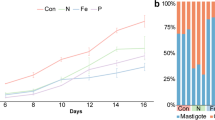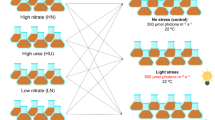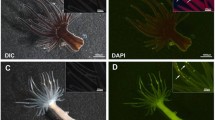Abstract
Endosymbiosis is an intriguing plant–animal interaction in the dinoflagellate–Cnidaria association. Throughout the life span of the majority of corals, the dinoflagellate Symbiodinium sp. is a common symbiont residing inside host gastrodermal cells. The mechanism of regulating the cell proliferation of host cells and their intracellular symbionts is critical for a stable endosymbiotic association. In the present study, the cell cycle of a cultured Symbiodinium sp. (clade B) isolated from the hermatypic coral Euphyllia glabrescens was investigated using flow cytometry. The results showed that the external light–dark (L:D) stimulation played a pivotal role in regulating the cell cycle process. The sequential light (40–100 μmol m−2 s−1 ~ 12 h) followed by dark (0 μmol m−2 s−1 ~ 12 h) treatment entrained a single cell cycle from the G1 to the S phase, and then to the G2/M phase, within 24 h. Blue light (~450 nm) alone mimicked regular white light, while lights of wavelengths in the red and infrared area of the spectrum had little or no effect in entraining the cell cycle. This diel pattern of the cell cycle was consistent with changes in cell motility, morphology, and photosynthetic efficiency (F v /F m ). Light treatment drove cells to enter the growing/DNA synthesis stage (i.e., G1 to S to G2/M), accompanied by increasing motility and photosynthetic efficiency. Inhibition of photosynthesis by 3-(3, 4-dichlorophenyl)-1, 1-dimethyl-urea (DCMU) treatment blocked the cell proliferation process. Dark treatment was required for the mitotic division stage, where cells return from G2/M to G1. Two different pools of adenylyl cyclase (AC) activities were shown to be involved in the growing/DNA synthesis and mitotic division states, respectively.










Similar content being viewed by others
References
Baker AC (2003) Flexibility and specificity in coral-algal symbiosis: diversity, ecology and biogeography of Symbiodinium. Annu Rev Ecol Evol Syst 34:661–689
Beer S, Ilan M, Eshel A, Weil A, Brickner I (1998) Use of pulse amplitude modulated (PAM) fluorometry for in situ measurements of photosynthesis in two Red Sea faviid corals. Mar Biol 131:607–612
Brunelle SA, Hazard ES, Sotka EE, van Dolah FM (2007) Characterization of a dinoflagellate cryptochrome blue-light receptor with a possible role in circadian control of the cell cycle. J Phycol 43:509–518
Chen CS, Lin HP, Yeh CC, Fang LS (2005) Use of a fluorescent membrane probe to identify zooxanthellae in hospite among dissociated endoderm cell culture from coral. Protoplasma 226:175–179
Coffroth MA, Santos SR (2005) Genetic diversity of symbiotic dinoflagellates in the genus Symbiodinium. Protist 156:19–34
Coles SL, Brown BE (2003) Coral bleaching-capacity for acclimatization and adaptation. Adv Mar Biol 46:183–223
Dimond J, Carrington E (2008) Symbiosis regulation in a facultatively symbiotic temperate coral: zooxanthellae division and expulsion. Coral Reefs 27:601–604
Douglas AE (2003) Coral bleaching - how and why? Mar Pollut Bull 46:385–392
Erickson JM, Rahire M, Rochaiz JD, Mets L (1985) Herbicide resistance and cross-resistance: changes at three distinct sites in the herbicide-binding protein. Science 228:204–207
Falkowski PG, Dubinsky Z, Muscatine L, McCloskey L (1993) Population control in symbiotic corals. Bioscience 43:606–611
Fitt WK (2000) Cellular growth of host and symbiont in a cnidarian-zooxanthellar symbiosis. Biol Bull 198:110–120
Fitt WK, Trench RK (1983) The relation of diel patterns of cell division to diel patterns of motility in the symbiotic dinoflagellate Symbiodinium microadriaticum Freudenthal in culture. New Phytol 94:421–432
Fitt WK, Brown BE, Warner ME, Dunne RP (2001) Coral bleaching: interpretation of thermal tolerance limits and thermal thresholds in tropical corals. Coral Reefs 20:51–65
Frade PR, De Jongh F, Vermeulen F, van Bleijswijk J, Bak RP (2008) Variation in symbiont distribution between closely related coral species over large depth ranges. Mol Ecol 17:691–703
Furla P, Allemand D, Shick JM, Ferrier-Pages C, Richier S, Plantivaux A, Merle PL, Tambutte S (2005) The symbiotic anthozoan: a physiological chimera between alga and animal. Integr Comp Biol 45:595–604
Hoegh-Guldberg O (1999) Climate change, coral bleaching and the future of the world’s coral reefs. Mar Freshw Res 50:839–866
Huang HJ, Wang LH, Peng SE, Hsiao YY, Chang CY, Fang LS, Chen CS (2007) New cell model for endosymbiosis research: spontaneous dissociation of endoderm cells based on tissue polarity in coral. Platax 4:9–25
Johnson RA, Desaubry L, Bianchi G, Shoshani I, Lyons E, Taussig R, Watson PA, Cali JJ, Krupinski J, Pieroni JP, Iyengar R (1997) Isozyme-dependent sensitivity of adenylyl cyclases to P-site-mediated inhibition by adenine nucleosides and nucleoside 3′-polyphosphates. J Biol Chem 272:8962–8966
Kadono T, Kawano T, Hosoya H, Kosaka T (2004) Flow cytometric studies of the host-regulated cell cycle in algae symbiotic with green paramecium. Protoplasma 223:133–141
Karako-Lampert S, Katcoff DJ, Achituv Y, Dubinsky Z, Stambler N (2005) Responses of Symbiodinium microadriaticum clade B to different environmental conditions. J Exp Mar Biol Ecol 318:11–20
Kuhl M, Cohen Y, Dalsgaard T, Jorgensen BB, Revsbech NP (1995) Microenvironment and photosynthesis of zooxanthellae in ccleractinian corals studied with microseensors for O2, pH and light. Mar Ecol Prog Ser 117:159–172
LaJeunesse TC (2004) “Species” radiations of symbiotic dinoflagellates in the Atlantic and Indo-Pacific since the Miocene-Pliocene Transition. Mol Biol Evol 22:570–581
Lam CMC, New DC, Wong JTY (2001) cAMP in the cell cycle of the dinoflagellate Crypthecodinium cohnii (Dinophyta). J Phycol 37:79–85
Lee Y, Lee HS, Lee JS, Kim SK, Kim SH (2008) Hormone-and light-regulated nucleocytoplasmic transport in plants: current status. J Exp Bot 59:3229–3245
Leighfield TA, Van Dolah FM (2001) Cell cycle regulation in a dinoflagellate, Amphidinium operculatum: identification of the diel entraining cue and a possible role for cyclic AMP. J Exp Mar Biol Ecol 262:177–197
McAuley PJ (1985) The cell cycle of symbiotic Chlorella I. The relationship between host feeding and algal cell growth and division. J Cell Sci 77:225–239
Munzner P, Voigt J (1992) Blue light regulation of cell division in Chlamydomonas reinhardtii. Plant Physiol 99:1370–1375
Oldenhof H, Bisova K, van den Ende H, Zachleder V (2004) Effect of red and blue light on the timing of cyclin-dependent kinase activity and the timing of cell division in Chlamydomonas reinhardtii. Plant Physiol Biochem 42:341–348
Oldenhof H, Zachleder V, van den Ende H (2006) Blue-and red-light regulation of the cell cycle in Chlamydomonas reinhardtii (Chlorophyta). Eur J Phycol 41:313–320
van Oppen MJ, Mieog JC, Sanchez CA, Fabricius KE (2005) Diversity of algal endosymbionts (zooxanthellae) in octocorals: the roles of geography and host relationships. Mol Ecol 14:2403–2417
Peng SE, Luo YJ, Huang HJ, Lee IT, Hou LS, Chen WNU, Fang LS, Chen CS (2008) Isolation of tissue layers in hermatypic corals by N-acetylcysteine: morphological and proteomic examinations. Coral Reefs 27:133–142
Perez SF, Cook CB, Brooks WR (2001) The role of symbiotic dinoflagellates in the temperature induced bleaching response of the subtropical sea anemone Aiptasia pallida. J Exp Mar Biol Ecol 256:1–14
Pfister K, Steinback KE, Gardner G, Arntven CJ (1981) Photoaffinity labeling of an herbicide receptor protein in chloroplast membranes. Proc Nat Acad Sci USA 78:981–985
Reimer AA (1971) Obswervations on the relationships between several species of tropical Zoanthids (Zoanthidae, Coelenterata) and their zooxanthellae. J Exp Mar Biol Ecol 7:207–214
Rowan R, Powers DA (1991) A molecular genetic classification of zooxanthellae and the evolution of animal-algal symbiosis. Science 251:1348–1351
Rowan R, Knowlton N, Baker A, Jara J (1997) Landscape ecology of algal symbionts creates variation in episodes of coral bleaching. Nature 388:265–269
Salih A, Hoegh-Guldberg O, Cox G (1998) Photoprotection of symbiotic dinoflagellates by fluorescent pigments in reef corals. Proc Aust Coral Reef Soc Conf. Greenwood JG, Hall NJ (eds) School of Marine Science, University of Queensland, Brisbane, 1998), pp 217–230
Salih A, Larkum A, Cox G, Kuhl M, Hoegh-Guldberg O (2000) Fluorescent pigments in corals are photoprotective. Nature 408:850–853
Smith GJ, Muscatine L (1999) Cell cycle of symbiotic dinoflagellates: variation in G1 phase-duration with anemone nutritional status and macronutrient supply in the Aiptasia pulchella-Symbiodinium pulchrorum symbiosis. Mar Biol 134:405–418
Spudich JL, Sager R (1980) Regulation of the Chlamydomonas cell cycle by light and dark. J Cell Biol 85:136–145
Wong JTY, Kwok ACM (2005) Proliferation of dinoflagellates: blooming or bleaching. BioEssays 27:730–740
Yee MC, Bartholomew JC (1989) Effects of 3-(3, 4-dichlorophenyl)–1, 1-dimethyl-urea on the cell cycle in Euglena gracilis. Plant Physiol 91:1025–1029
Acknowledgments
This work was supported by grants from the National Science Council NSC 93–2311-B-291-002, NSC 93-2311-B-291-003 and NSC 94-2311-B-291-003, and by intramural funding from the National Museum of Marine Biology and Aquarium. Constructive comments on the manuscript from two anonymous reviewers and the editor are greatly appreciated.
Author information
Authors and Affiliations
Corresponding author
Additional information
Communicated by Biology Editor Dr Michael Lesser
Rights and permissions
About this article
Cite this article
Wang, LH., Liu, YH., Ju, YM. et al. Cell cycle propagation is driven by light–dark stimulation in a cultured symbiotic dinoflagellate isolated from corals. Coral Reefs 27, 823–835 (2008). https://doi.org/10.1007/s00338-008-0434-z
Received:
Revised:
Accepted:
Published:
Issue Date:
DOI: https://doi.org/10.1007/s00338-008-0434-z




